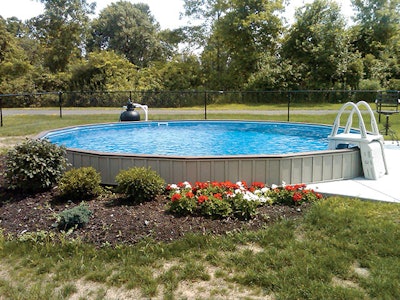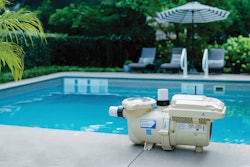
"Meet me halfway."
You know the phrase. But this time, we're not talking about compromises. Instead, we're talking about the semi-inground pool, an aboveground/inground hybrid that can sit entirely aboveground, sink halfway or be entirely submerged.
While the pool is a literal halfway point between inground and aboveground, it's also growing in popularity in a new niche market: the inbetweeners. Like the semi-inground itself, this halfway market consists of people who are willing to spend a little more money than the cost of a traditional aboveground, but don't have quite enough to invest in an inground pool.
Thanks to the semi-inground, customers have a wider range of options to accommodate their budget and retailers have a new market to target. No compromises necessary.
Everything to Everyone
Dean Rice of Rice Pools in Hermitage, Pa, specializes in custom inground pools. But when he was introduced to the Ultimate Pool, Fabcote's semi-inground model, he saw it catered to a different need in the industry.
"It's doubled our sales this year," Dean says. "As soon as you tell a customer you can put it inground, their eyes light up because people don't want to stare out a window and look at the side of a pool in their backyard."
In a world where you supposedly can't get everything you want, Rice says the semi-inground pool offers customers a chance to do just that.
"I had a lady come in here, she wanted a 21-foot-round aboveground pool," Rice says. "So we told her about our pool, and the last thing I said to her was, 'Ma'am, we can sink this in the ground.' And immediately her eyes lit up and she got this gigantic expression on her face like 'Oh my God, you can?" And she kept saying it over and over again!"
This year, Rice sold 12 semi-inground pools, and he already has two sold for the 2013 season. When it comes to the model's success, Rice credits the pool's versatility, quality and ease of installation. Semi-inground pools can be installed in a matter of days and are DIY-friendly — five of Rice's sales were to DIY-ers.
"It's worked out in all aspects. It's doubled our sales, and the funny thing about them is, most of them we're putting inground," Rice says. "They're actually getting an inexpensive inground pool."
Laying the Groundwork
Although sold by aboveground dealers, the semi-inground is a more robust pool intended for longer life. Fabcote's units, for instance, use 14-gauge galvanized steel, with their usual inground panels lengthened from 42 inches to 52 inches (yet still lightweight enough for DIY-minded customers).
"Structurally, it's as strong as an inground pool," says Clark Wherley of Fabcote. "And that's what people have really liked about this product."
While semi-ingrounds tend to be more expensive than the average aboveground, Wherley says customers are not only willing to spend more on pools, but also on extras like new decks and poured concrete.
"From our standpoint, it's a new market," Wherley says. "It's a price-point product for those people who really can't afford a full-blown inground pool, but they can afford maybe half of that cost, so to speak, and make that money available to put our product in as a semi-inground pool."
"The dealers like it," he says, "because they can get into that $10,000 to $20,000 market as an inground pool product."
A New Market
{bglink 4677}This was Brian Zettle's first year selling semi-inground pools. The President of BZ Poles and Decks, Inc. in Johnstown, Pa; Zettle sells an average of 30 to 35 aboveground pools annually — and last year, six of those were semi-inground pools.
"It basically opened a whole new market...I believe there's that middle-class market that's not quite able to afford that $25,000 to $30,000 inground, but at the same time, the husband says, 'I'm not sticking that ugly thing in the middle of my yard,'" Zettle says. "So whenever you hit them with that happy medium, $10,000 to $12,000, that's where I'm finding a whole new niche."
When discussing aboveground pools, aesthetics are always an issue. Yet with the semi-inground pool, Zettle finds aesthetics are less problematic. When partially or entirely sunk, wall visibility is minimized. And some brands offer color choices for better color coordination between the pool and the home.
In addition to visual aesthetics, Zettle also noticed his customers sought pools that work in tandem with pre-existing structures in their backyards, namely, decks.
"I find a lot of people saying, 'I have this deck coming off of my house.' It's only three steps down to the yard, and they want the pool at deck height, and the only way to do that is to sink it in the ground," Zettle says.
Another selling point: Zettle says the semi-inground pool is not classified as a permanent structure, meaning it's not subject to additional property taxes like inground pools are.
Up in the Air
While semi-inground pools are a growing market, they are also slow to find acceptance among aboveground dealers. Here's one reason why: Many aboveground specialists are ill-equipped for the digging a semi-inground may require, making them wary of the new model. However, as lower-end aboveground sales have eroded because of big box stores and the internet, the semi-inground, when marketed as a high-end aboveground, is becoming attractive to some dealers.
In other words, as one door closes, another opens.
Above and Beyond
The pool industry is still recovering from the economic climate of the past few years. According to our experts, the key to the growing success of the semi-inground pool comes down to one word: affordability.
"It's the price point and what the homeowner can afford," Wherley says. "And I think everybody is just trying to figure out that new market...everybody in the industry is looking for more affordable pools, quicker installation and yet the ability to make a profit."
Who's Who of the New Niche
Fact: families flock to pool retailers. But which member of the family is controlling the purse strings?
"Ninety percent of the time, the female is the driving factor for getting a pool," Zettle says. "In the inground market, more guys are involved because with that kind of money, it's got to be something he wants too. Abovegrounds are, for the most part, moms who are home all summer with the kids, and it's 'buy me a pool or central air,' because when it gets hot, they need something,"
Financially-fueled decisions, like choosing between central air or a swimming pool, are only the beginning. Zettle says other factors come into play for families considering a pool.
"Instead of going on vacation, people are having their vacations in their backyard with something they can have long-term," Zettle says.
Next time you're talking with a potential customer, try focusing on the entire family-fun-and-togetherness budget and see if you close the deal.
—C.H.
Comments or thoughts on this article? Please e-mail [email protected].










































